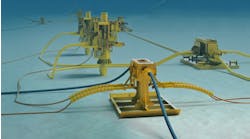The very public protest to Shell’s 1995 proposal to dispose of the Brent Spar oil storage facility to deepwater in the Atlantic raised the profile of the environment in decommissioning decisions in the UK. The effects of the protest are reflected in the provisions of the Petroleum Act 1998, which now require the owners of an offshore installation to submit a decommissioning program for approval by the Department of Trade and Industry (DTI). The DTI have made it clear that environmental considerations will be important in shaping these programs.
The combination of deepwater and severe weather in the northern North Sea means that the installations are some of the heaviest in the world and this presents particular problems for decommissioning. The current estimate is that most of the 400 or so offshore structures in UK waters are likely to be decommissioned within the next 15 years with about 80% being completely removed. The structures will be disassembled into manageable pieces, loaded onto barges, and brought to shore for re-use, recycling, or disposal. The environmental considerations therefore will be concerned principally with the management of waste. The most obvious manifestation of waste will probably be the structure itself, including the topside, deck, jacket, and footings. There may also be pipelines and other associated subsea installations. On the platform, there may be redundant chemicals and other wastes. Some plant and equipment may be radioactively contaminated, and there may be debris on the sea bed along with piles of drill cuttings.
The handling of waste is central to decommissioning. The DTI guidance notes on decommissioning state that it will be important to include in the program a statement indicating how the government’s waste hierarchy will be met. The waste hierarchy ranks the options for dealing with waste in terms of their sustainability. Waste reduction is the first ranking option, followed by re-use for the same or a different purpose, then recycling, and disposal is the last option. Securing the re-use of large installations can be problematic but Kerr McGee successfully sold the tension leg Hutton platform for re-use and Talisman is re-using some of the infrastructure from the Beatrice field for a wind farm demonstration project.
An environmental impact assessment is to form part of the decommissioning program. The assessment is a means of drawing together in a systematic way an assessment of a project’s likely significant environmental effects. The guidance notes state that the chosen decommissioning option should be supported with an assessment.
To secure the re-use or recycling of installations, transportation out of UK waters may be contemplated, as was the case with Philip’s Maureen platform. This will require compliance with regulations dealing with the trans-frontier shipment of waste. The regulations promote the principles of self-sufficiency (disposal by states of their own waste) and proximity (disposal as near to the origin of the waste as possible). This suggests that approval is unlikely to be given to the trans-frontier shipment of waste for disposal.
If an installation is being brought ashore for processing in the UK, then consideration must be given to the relevant domestic regulations. Operators may be tempted, where disassembled installations have been removed to shore, to wash their hands of the matter. However, while ownership or control of the waste may have passed from the operator, a continuing duty of care is imposed on all parties in the waste chain. For the operator, this is likely to mean ensuring that the waste is adequately contained and described and checking that the carrier of the waste is properly registered and that the waste is passed for processing to an appropriately licensed site.
Radioactive scales and sludges can form in production systems during offshore operations, particularly in the northern North Sea. Normal practice offshore is to attempt to flush out the scale. Most platforms where this problem arises have an authorisation for this. In some cases, plant and equipment may have to be removed and brought on shore for decontamination or disposal by specially licensed contractors.
Whatever the intentions for the installation and its components, consideration must also be given to the state of the seabed around the installation. It is likely, for example, that a certain amount of debris will have accumulated around the installation during its operational life and on decommissioning and some contamination may have occurred. The guidance notes state operators will be required to identify and deal with such debris and contamination and independent verification will be required.
A particular issue with regard to the state of the seabed around drilling platforms in the deep waters of the northern North Sea will be what to do with the drill cuttings that have accumulated from drilling operations. Until 1996, cuttings were often contaminated with oil-based drilling mud and heavy metals. The result is that a considerable legacy of contaminated cuttings has built up. Research undertaken by the UK Offshore Operators Association concludes that if the cutting piles have a significant potential impact, covering or recovery to shore will be the preferred options.
While the offshore industry has considerable experience in the handling of waste, it is the amount and nature of the waste arising on decommissioning that is likely to present a challenge.
Professor Jeremy Rowan-Robinson


